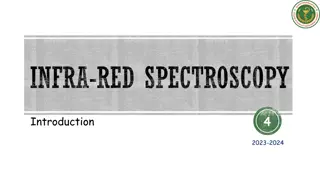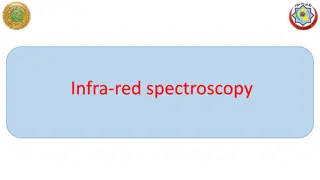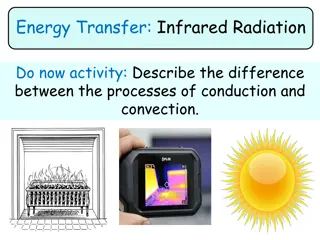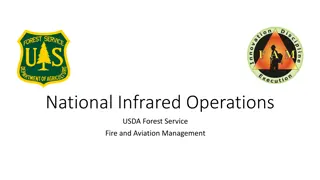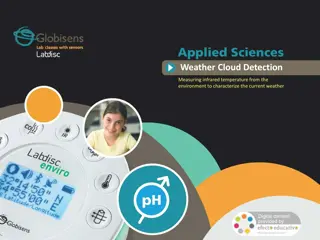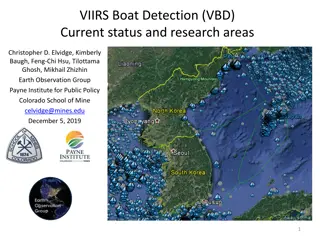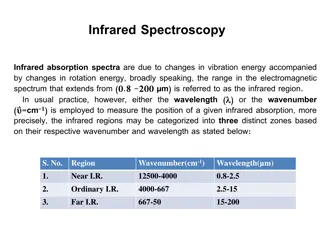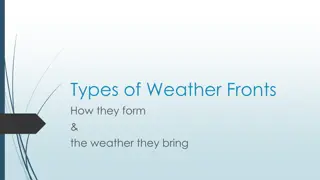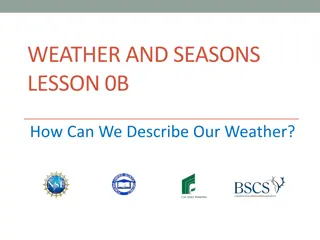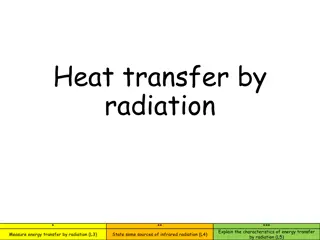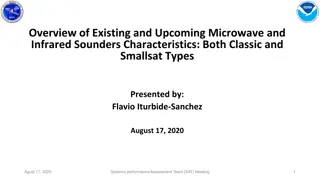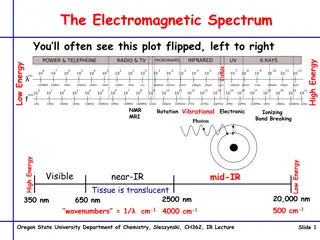Exploring Weather through Infrared Temperature Detection
Studying everyday weather using infrared temperature detection from the environment can help in understanding the relationship between temperature variations of different objects and weather conditions. This activity involves creating hypotheses and testing them using an infrared temperature sensor. Infrared radiation emitted by objects is utilized to analyze and characterize weather patterns. The experiment aims to define temporal weather changes based on local environmental cues, such as radiated heat from objects. By observing heat radiation and cloud formations, the experiment enhances knowledge of climate modeling and weather prediction.
Download Presentation

Please find below an Image/Link to download the presentation.
The content on the website is provided AS IS for your information and personal use only. It may not be sold, licensed, or shared on other websites without obtaining consent from the author.If you encounter any issues during the download, it is possible that the publisher has removed the file from their server.
You are allowed to download the files provided on this website for personal or commercial use, subject to the condition that they are used lawfully. All files are the property of their respective owners.
The content on the website is provided AS IS for your information and personal use only. It may not be sold, licensed, or shared on other websites without obtaining consent from the author.
E N D
Presentation Transcript
Weather Cloud Detection Measuring infrared temperature from the environment to characterize the current weather
Weather Cloud Detection Measuring infrared temperature from the environment to characterize the current weather Objective The purpose of this activity is to study everyday weather via IR- temperature detection from the environment, creating a hypothesis and proceeding to test it using the SensorLab infrared temperature sensor.
Weather Cloud Detection Measuring infrared temperature from the environment to characterize the current weather Introduction and theory All bodies emit infrared (IR) radiation which depends on the temperature and composition of objects. Due to the nature of this type of electromagnetic energy, heat transmission between two or more bodies occurs without a physical medium and is highly efficient. This type of radiation has a wide range of applications related to heating and IR-temperature detection.
Weather Cloud Detection Measuring infrared temperature from the environment to characterize the current weather Introduction and theory Have you felt radiated heat from different objects without touching them? Is there any relation between the temperature from different objects around you and clear or cloudy days? Carry out the experiment activity with your class so that at the end you ll be able to answer the following question: How could you define the temporal weather from the local environment?
Weather Cloud Detection Measuring infrared temperature from the environment to characterize the current weather Introduction and theory Theoretical Detection of this type of infrared radiation covers the determination of gas concentration, night vision and one of the most interesting applications: Climate modeling. The infrared detection of temperature has been used to evaluate the weather based on the visual inspection of the sky via satellite temperature detection. This technique allows us to describe the movement and presence of different types of clouds because heat radiation from Earth into outer space is blocked by the presence of clouds (e.g. higher or more saturated clouds are cooler than the ground).
Weather Cloud Detection Measuring infrared temperature from the environment to characterize the current weather Introduction and theory These detection systems have been implemented in climate studies allowing the construction of weather maps, where the temperature range is shown as a black and white scale low temperatures are close to white and high temperatures are close to black.
Weather Cloud Detection Measuring infrared temperature from the environment to characterize the current weather Introduction and theory Now students are encouraged to raise a hypothesis which must be tested with an experiment. How do you think temperature would vary when measuring sky and ground environments?
Weather Cloud Detection Measuring infrared temperature from the environment to characterize the current weather Activity description Students will measure infrared temperature from a clear and cloudy sky, the ground and different nearby objects. They will evaluate the method relating their observations to the experimental results.
Weather Cloud Detection Measuring infrared temperature from the environment to characterize the current weather Resources and materials SensorLab 1 Enviro
Weather Cloud Detection Measuring infrared temperature from the environment to characterize the current weather Using the SensorLab SensorLab configuration To collect measurements with the SensorLab pH sensor, the SensorLab must be configured according to the following steps: Turn on the SensorLab pressing 1 Press and select SETUP by pressing 2
Weather Cloud Detection Measuring infrared temperature from the environment to characterize the current weather Using the SensorLab Now select the SET SENSORS option with temperature, then press . and select the IR Once you have done that, you will be back at the setup menu. Press one time and select SAMPLING RATE with . Choose MANUAL . Now, go back to the measurements pressing three times. Start measuring with and press every time you want to record a data. Once you are finished measuring stop the SensorLab by pressing (you will see the instruction Press SCROLL key to STOP ) and press .
Weather Cloud Detection Measuring infrared temperature from the environment to characterize the current weather Experiment Place the SensorLab in an open field. Record the infrared temperature pointing the sensor towards different objects around you, including a cloudy sky sample and a ground sample. Stop the SensorLab. Repeat the previous steps with a clear sky.
Weather Cloud Detection Measuring infrared temperature from the environment to characterize the current weather Results and analysis Connect the SensorLab to the computer using the USB communication cable or via the Bluetooth wireless communication channel. On the upper menu press and select . Choose the penultimate (second last) experiment of the list. Select a bar graph label bars using the tool . Then, look at the data table to calculate the difference between ground and sky temperatures. from the GlobiLab menu to show the experiment results and Now select the last experiment of the list and repeat step three.
Weather Cloud Detection Measuring infrared temperature from the environment to characterize the current weather Results and analysis Considering your thermal sensation at the study site, did you expect these results? What is the difference between ground and sky temperatures in each experiment? Are the differences similar? How are the results related to your initial hypothesis?
Weather Cloud Detection Measuring infrared temperature from the environment to characterize the current weather Results and analysis The graph below should be similar to the ones the students came up with:
Weather Cloud Detection Measuring infrared temperature from the environment to characterize the current weather Results and analysis
Weather Cloud Detection Measuring infrared temperature from the environment to characterize the current weather Conclusion What do the different IR emissions of objects and ground depend on? Students should indicate that the composition and temperature of the objects and ground determine the IR temperature differences. They also must consider that the available solar radiation is fundamental in heating the environment. Why did a clear sky show lower temperature than a cloudy sky? Students should point out that outer space is cold because it is an empty place. Our atmosphere keeps constant low temperatures to maintain a thermal equilibrium between lost heat into space and heat gain from sun radiation. On the contrary, the clouds are atmospheric objects which radiate IR emissions and work as a shield, preventing heat from escaping from the earth.
Weather Cloud Detection Measuring infrared temperature from the environment to characterize the current weather Conclusion Is infrared temperature detection an objective method to determine the weather? Students should conclude, based on the experimental evidence, that there is a correlation between the weather and the IR temperature of the environment (ground, sky, rocks, plants and others) due to the amount of infrared radiation. This variable can be measured quantitatively relying on the complete transmission of the IR-radiation through the transmission medium.
Weather Cloud Detection Measuring infrared temperature from the environment to characterize the current weather Activities for further application Higher temperatures have been recorded during overcast days compared to clear sky days over the same season. Why does this happen? Students should suggest that clouds block heat from escaping from the ground and transmit infrared radiation back. The temperature difference between the ground and a cloudy sky should therefore be low. How could you prove a relation between sea water temperature and continuous rain in certain tropical regions? What would happen in other climate regions? Students could suggest that they record water temperatures and then carry out the learned method to detect the weather condition over time. They can expect to find a correlation between the water temperature and the frequency of rains during different seasons.




